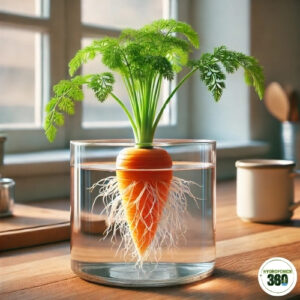How to Grow Hydroponic Carrots Easily
Table Of Content
Carrots are quite a good candidate for hydroponic cultivation due to their nutritional value, versatility in recipes, and high market demand. Being rich in vitamins A and K alongside fiber, hydroponic carrots form a very healthy diet and are quite common in almost every cuisine. Its compact growth habit makes it quite suitable for controlled environments.
Allow me to give details about hydroponic carrots.

Basics of Growing Carrots
You should know some basic information about hydroponic carrots before you grow them.
What Kind of Carrots Can You Grow?
The best types of carrots to use in a hydroponic system are short-rooted, such as Nantes, Chantenay, and Mini Carrots. These types are most suitable for growth in containers and develop properly without the deep structure of soil as required in traditional farming.
What Do You Need for Growing Carrots?
In my own experience, maintaining consistent nutrient levels and optimal temperatures played a crucial role in reaching this timeline. For example, a minor adjustment in the nutrient mix during one cycle noticeably improved growth.
Additionally, using full-spectrum LED lighting for 12–16 hours a day—with a balanced mix of blue and red wavelengths—supports effective photosynthesis and robust root and foliage development.
Choosing the right container is essential for accommodating the natural depth that carrot roots require. I initially experimented with shallow containers, which limited root expansion and led to underdeveloped carrots. Later, I switched to deep containers, and the difference was remarkable—the carrots developed much better, with proper root depth and overall improved structure. Specialized vertical arrangements can also be beneficial, as they are designed to allow ample space for root expansion while efficiently utilizing growing space.
What about the Hydroponic Systems? Which One Is Good for Carrots?
For growing hydroponic carrots, media-based systems such as ebb and flow or drip irrigation setups with inert substrates (like coco coir, perlite, or expanded clay pellets) are generally the best option. These systems provide the necessary support for root development and proper drainage while ensuring consistent nutrient delivery.
For example, I initially tried a Nutrient Film Technique (NFT) system, but the shallow root zone didn’t allow the carrots to develop properly, and the results were disappointing. Later, I switched to an ebb and flow system with a media bed, and the improvement was clear—the carrots developed robust roots and showed a noticeable increase in overall health and yield.
Planting and Maintenance
Carrot seeds germinate best in a moist, inert growing medium, and using a humidity dome helps maintain the right moisture levels during this important stage.
Once the seedlings have formed their first true leaves, they should be carefully transplanted into their hydroponic system. After that, just make sure that a steady supply of oxygenated nutrient solution keeps the roots healthy and watch the nutrient levels carefully to avoid deficiency or excess conditions, which can stunt growth.
Time to Prune
Pruning and thinning early are very critical in hydroponic carrot cultivation to prevent overcrowding, which can lead to misshapen roots and uneven development. In one of my early growing cycles, I skipped proper thinning, and the overcrowded plants resulted in deformed roots that affected both yield and quality. This experience taught me the importance of removing excess plants early on to ensure that each carrot has sufficient space and nutrients to grow uniformly.
Harvesting and Post-Harvest
Carrots are ready to be harvested at the stage of maturity, where they reach their full size and color. A light pull test confirms the time of maturity. In order not to break the roots, firstly loosen the media by using a soft grip on it before carefully pulling out the carrots while keeping the roots intact.
Hydroponic carrots will store well in a cool, humid environment after harvest. Washing and good packaging, in addition to extending the shelf life, improve marketability.
Benefits of Hydroponic Carrots
I want to share the benefits of hydroponic carrots to convince you to grow this delicious vegetable.
Sustainability:
Hydroponic systems recycle water through closed-loop systems, significantly reducing water usage compared to traditional farming. The controlled environment also minimizes the need for pesticides, leading to a more eco-friendly and sustainable production method. In my own experience, this approach not only conserves water but also creates a cleaner growing environment.
Efficiency:
With precise control over factors such as nutrient delivery, lighting, and temperature, hydroponic systems often yield higher productivity in a smaller footprint. This controlled environment allows for faster growth cycles and more consistent crop quality, maximizing overall efficiency.
Economic Potential:
Hydroponic carrot cultivation offers opportunities to tap into local and niche markets by providing fresh, high-quality produce year-round. Many growers find that the ability to produce pesticide-free and sustainably grown carrots can command premium prices in specialty markets, enhancing the economic viability of the venture.
Challenges and Solutions of Growing Hydroponic Carrots
Growing hydroponic carrots presents a few challenges that can be managed with careful attention.
One common issue is overcrowding; if the seedlings are too close together, the roots may become misshapen, and the plants can struggle to develop evenly. Thinning the plants early ensures that each carrot has enough space to grow properly.
Another set of challenges in hydroponic carrot cultivation involves maintaining proper water circulation and stable temperatures. When water movement is insufficient, the nutrient solution can become stagnant, reducing the dissolved oxygen levels that roots need to thrive.
In one instance, a malfunctioning pump led to stagnant water, and I quickly noticed early signs of root rot and fungal growth. Adding extra air stones and ensuring regular water flow helped restore healthy oxygen levels in the root zone.
Temperature fluctuations can also stress hydroponic carrots. Rapid or extreme changes in temperature may encourage pathogens or disrupt nutrient uptake, ultimately affecting the overall growth and uniformity of the crop.
I once had my system placed near a window, where direct sunlight caused significant temperature spikes during the day and cooler periods at night. Once I moved the setup to a more controlled environment, the carrots grew more consistently and with better quality.
FAQs
How often is the nutrient solution changed?
Nutrient solutions should be changed every 1 to 2 weeks to avoid any type of imbalance for optimum crop growth.
Do hydroponic carrots taste different from carrots grown in soil?
Hydroponic carrots have a cleaner taste, somewhat sweeter, due to the precision in nutrient feed.
What is the most common problem in attempting to grow carrots hydroponically?
The most frequent problem is poor root development from a lack of depth within the growing medium.
Is it possible to grow carrots hydroponically indoors?
Yes, it is quite possible to grow carrots indoors with sufficient light, proper temperature, and adequate ventilation.
When can you eat hydroponic carrots?
Hydroponically grown carrots typically take about 70–80 days from germination to harvest, depending on environmental conditions and nutrient management.
Table Of Content
